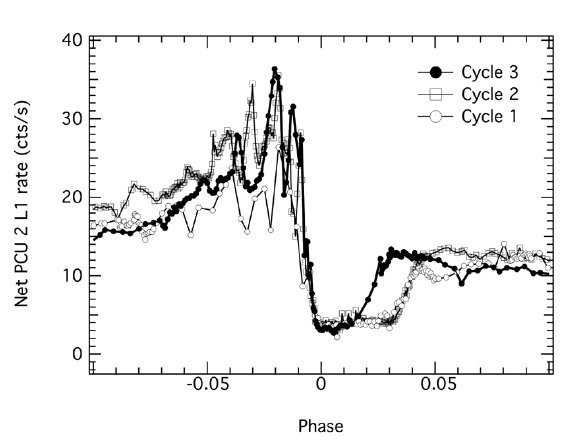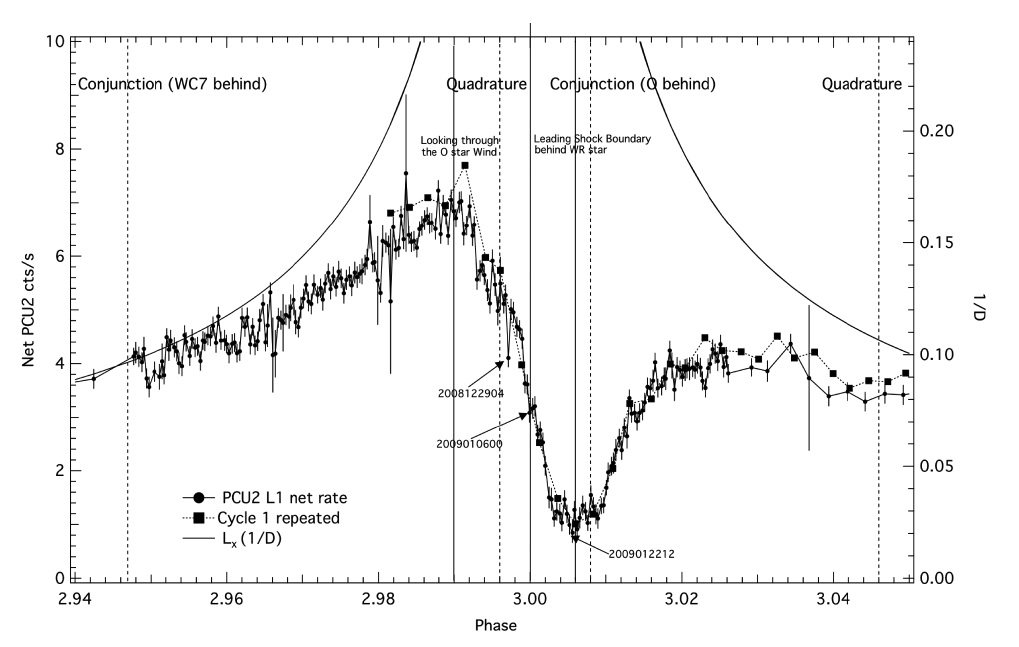



The most massive stars (M > 60
2. WIND-WIND COLLISIONS AS A BINARY DIAG-NOSTIC
However, in massive binaries, the strong stellar wind possessed by at least one (and, usually, both) of the stars will interact with the radiation and (in most cases) the wind outflowing from the companion star’s surface. Bob Koch and his collaborators, notably Ray Pfeiffer and Ioan-nis Pachoulakas, recognized this fact long ago (Pfeiffer et al. 1994, Pfeiffer et al. 1997), and developed surprisingly sophisticated models of the complex radiative transfer through the “moving envelope” (to use Sobolev’s termi-nology) of the binary: in these cases, in which the wind is moving in an azimuthal direction (due to orbital motion) in addition to the radial one.
A particularly interesting case occurs when the stel-lar wind from one star collides with a companion star’s wind. The shock-heated gas (typically at temperatures of millions of Kelvin) produced in this collision generates intense X-ray emission that provides a useful diagnostic of wind mass-loss rates and densities. If the cooling of the shocked gas from the star is dominated by adiabatic expansion, then simple scaling laws show that the X-ray luminosity
is the mass loss rate,
Eta Carinae (= HD 93308) is a long-period (
? 10-3 M⊙ yr-1) , slow (
? 10-5M⊙ yr-1 ) but much faster (
As discussed in Pittard & Corcoran (2002) and Parkin et al. (2009), the X-ray variations can be modelled to yield values of the stellar wind parameters of Eta Car B, the star which has otherwise not been directly observed. Since wind terminal velocity
2.2 WR 140: A Shock Physics Laboratory
WR 140 (= HD 193793; WC7+O4-5) is arguably the best known example of a colliding wind system, and of the range of phenomena which may be associated with
[Table 1.] Parameters for the Eta Carinae System.

Parameters for the Eta Carinae System.
strong, time-variable astrophysical shocks. WR 140’s long period (
2.2.1 Modeling WR 140’s X-ray Emission
The PCA on RXTE has measured the X-ray lightcurve of WR 140 for over two cycles2. The coverage is not as ex-tensive or complete as it is for Eta Car, however two X-ray minima were measured in detail. Qualitatively, the phase-dependent X-ray variation of WR 140 is similar to that of Eta Car: there’s a gradual increase in 2?10 keV X-ray flux from apastron as the stars approach periastron passage; the X-ray flux grows as (roughly) 1/
cone apex is viewed through the lower density wind of the O4 companion; the X-ray flux falls to a minimum which occurs near the time when the leading edge of the shock cone is occulted by the WR star; and after this minimum, the flux recovers but the recovery is asymmetric, i.e. the level after the minimum is lower than the level at a similar mean anomaly prior to the minimum. Fig. 2 shows the observed 2?10 keV X-ray variation for the two periastron passages observed by RXTE.
Modeling the system with smoothed particle hydrody-namics calculations similar to those used to model the X-ray flux variations in Eta Car has had some success. As shown in Russell et al. (2011), simple models in which the X-ray flux is localized very near the apex of the shock cone provide good descriptions of the observed variation, though models in which the X-ray emitting region is dis-tributed along the shock cone (as expected in a realistic wind-wind collision) don’t describe the observed varia-tions as well.
1see http://asd.gsfc.nasa.gov/Michael.Corcoran/eta_car/etacar_rxte_lightcurve/ for the latest RXTE data
2see http://asd.gsfc.nasa.gov/Michael.Corcoran/wr140/wr140_rxte_lightcurves/ for the latest RXTE data
As a canonical colliding wind binary, the X-ray flux behavior of WR 140 around the orbit is remarkably well-behaved even if not yet entirely understood in detail. Im-portant features of its X-ray lightcurve (X-ray extrema, hardness ratio maximum, etc.) are well associated with significant orbital events deduced from radial-velocity and radio interferometric studies. In the Eta Car system as well, models of the phase-locked X-ray variations have been useful in determining the system parameters. How-ever, Eta Car is a star that’s notoriously badly behaved in almost every epoch and almost every energy band, and indeed the behavior of Eta Car’s X-ray flux shows signifi-cant non-phase-locked variations. Secular changes in the observed X-ray flux from Eta Car are probably the best in-dication of a fundamental change in the wind-wind inter-action zone. Such change must indicate a real variation in the stellar winds from either or both the primary and secondary.


